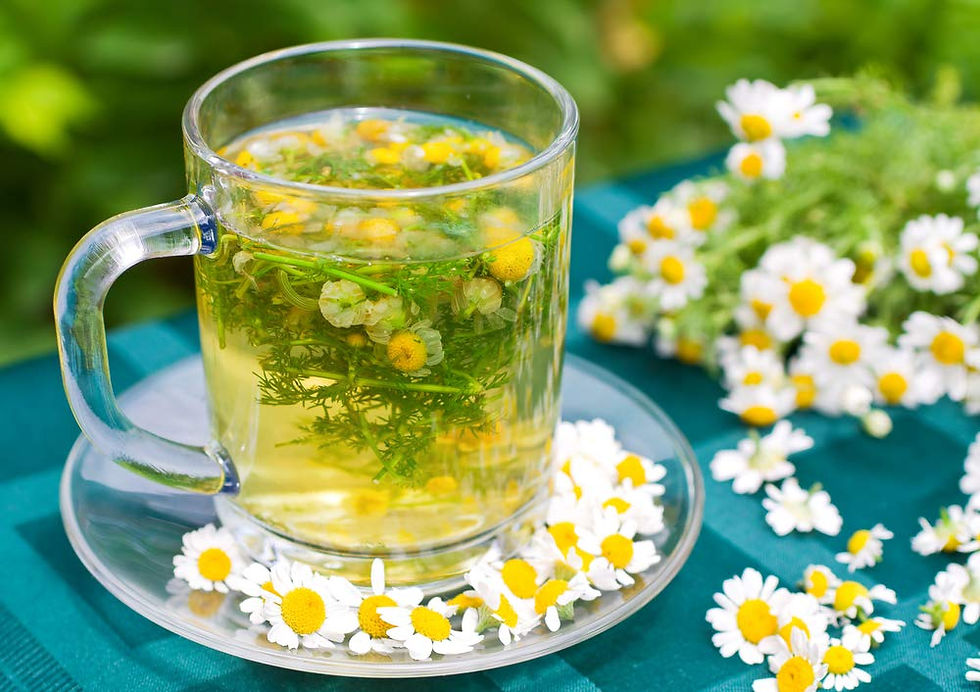Chamomile: Small Flower, Big Medicine
- Jodi McKee
- May 2, 2023
- 4 min read
Updated: Jul 23
Matricaria chamomilla
If there’s one herb that deserves a permanent spot in every herbalist’s apothecary, tea cabinet, and garden, it’s chamomile (Matricaria chamomilla). Often underestimated due to its delicate, daisy-like appearance and reputation as “that sleepytime tea,” chamomile is far more than a gentle bedtime brew. It’s a deeply intelligent, multi-talented, and dependable healer — the kind that meets you where you are and helps you come back into balance.
But first, the science stuff....
Common Name
Chamomile, camomile, German chamomile, Hungarian chamomile, manzanilla, scented mayweed, sweet false chamomile, true chamomile, wild chamomile
Family
Asteraceae
Native To
Southern and Eastern Europe

Botanical Description
The German chamomile plant is an herbaceous annual with delicate, feathery, mildly aromatic leaves in fine filiform segments growing from a smooth, branching stem that typically grows between 12 and 24 inches (30 and 60 cm) in height. The composite aromatic flowers measure between 0.4 and 0.8 inches (1 and 2 cm), arise from the apices of each individual stalk as a single flower, and feature white ray petals surrounding a yellow disk of tubular florets in the center.
Meet Chamomile: The Calming Queen of the Daisy Family
Chamomile belongs to the Asteraceae family—the same family as echinacea, yarrow, and dandelion. It’s a hardy annual with feathery foliage and tiny white blossoms with sunny yellow centers that smell faintly of apple and sunshine.
This sweet little flower has been used for thousands of years—by the Egyptians, Greeks, and Romans—for everything from calming nerves to soothing the stomach to promoting radiant skin. Its Latin name, Matricaria, even hints at its role as a nurturing herb: it stems from mater, meaning "mother." This is fitting since chamomile is often used to comfort, soothe, and ease, just like a loving mother.
Nervine, Sedative & Emotional Support
Chamomile is perhaps best known for its role as a nervine and gentle sedative, supporting the nervous system when frazzled, overworked, anxious, or just plain exhausted.
When to Reach for Chamomile:
Sleepless nights (especially for kids and sensitive sleepers)
Stress, overwhelm, or racing thoughts
Anxiety with digestive upset
Irritability, especially when tied to hormonal shifts or fatigue
Teething discomfort and cranky kids (it’s a parent’s best friend!)
Chamomile doesn’t knock you out — it invites your body to exhale, your muscles to unclench, and your mind to slow down just enough to let rest take over. It's the herbal equivalent of a warm bath and a cozy blanket.
Chamomile for Digestion: Gut, Meet Calm
Many people don’t realize that chamomile is just as powerful for the gut as it is for the nerves — in fact, the two are deeply connected (hello, vagus nerve!). Chamomile is a classic carminative herb that helps reduce gas, bloating, cramping, and all those unpleasant digestive hiccups.
It’s especially helpful when:
Digestive upset is tied to stress or emotion
There's inflammation in the gut lining (like with gastritis or IBS)
You’re experiencing nausea, colic, or indigestion
You’ve had too much rich food, caffeine, or a holiday celebration
It’s also mildly bitter, gently stimulating digestion and bile flow, helping your body better break down food.

Anti-inflammatory, Antispasmodic, and Gentle Enough for Almost Anyone
Chamomile is one of those rare herbs that can soothe both tension and inflammation, making it useful for a wide range of internal and external complaints.
Actions:
Anti-inflammatory – Calms skin, mucous membranes, and inflamed tissues
Antispasmodic – Eases cramping, spasms, and muscular tension
Vulnerary – Promotes healing of cuts, scrapes, and minor wounds
Antimicrobial – Useful in oral rinses and skin salves
It can be used for menstrual cramps, muscle aches, mouth ulcers, diaper rash, conjunctivitis, hemorrhoids, and more. It truly is a "whole-body softener."
How to Use Chamomile
Chamomile is versatile and plays well with others, though it's often effective on its own.
Infusion (tea):
Use 1–2 teaspoons of dried flowers per cup of boiling water
Cover while steeping for 10–15 minutes to capture the volatile oils
Sip warm for nervous system and digestive support
Tincture:
1–4 mL up to three times daily
Great for acute stress or for those who don’t love tea
Other uses:
Compress or poultice: For inflamed skin or sore eyes
Baths or sitz baths: For calming both mind and body
Steam: For irritated sinuses
Glycerites or teas for children: Chamomile is safe and incredibly effective for little ones
Final Thoughts: Your Gentle, Steady Herbal Companion
Chamomile may be soft-spoken, but don’t mistake her subtlety for weakness. She brings a steadfast calm, a deep intelligence, and the ability to soothe pain, inflammation, and emotional tension — often all at once. Whether you're sipping her warm tea on a rainy day or blending her into a healing salve, chamomile is the kind of friend you want close.
So if your life’s been a little too loud lately—too tense, too fast, too much—let chamomile bring you back to center.
Want to grow chamomile in your own medicinal garden?
📗 Download Harvest & Herb: A Modern Medicinal Garden to get planting, harvesting, and preparation tips for chamomile and other healing herbs.
Try a Chamomile Tincture: Supports Restful Sleep & Healthy Digestion.
The information offered on HealWise websites is for educational purposes only. HealWise makes neither medical claims nor is it intended to diagnose or treat medical conditions. Links to external sites are for informational purposes only. HealWise neither endorses them nor is in any way responsible for their content. Readers must do their own research concerning the safety and usage of any herbs or supplements.
.jpg)



Comments